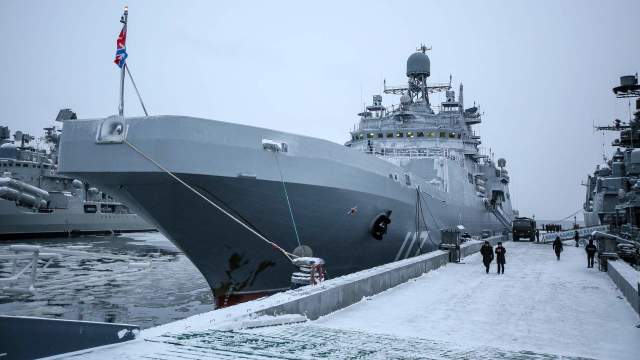Russian BDK will be equipped with drones and additional air defense systems
The firepower of large amphibious assault ships of the Russian Navy will be increased by Orlan and ZALA drones — this is provided for by the BDK modernization program adopted by the Ministry of Defense of the Russian Federation, sources in the military department told Izvestia. With the help of UAVs, crews will be able to adjust artillery fire and cover the landing. In addition, the BDK will be strengthened with additional air defense equipment. Amphibious ships perform important tasks during their combat operations, and the experience of special operations proves that it is necessary to increase their fire capabilities and protection, experts noted.
Based on combat experience
The program to enhance the combat capabilities of large amphibious assault ships (BDK) has been adopted by the Russian Ministry of Defense, sources told Izvestia in the military department. The decision on modernization was made based on the experience of the SVO and provides that the armament of the BDK will include unmanned aerial vehicles Orlan-10 and ZALA. Their task is to adjust the fire of onboard artillery when firing at both sea and land targets.
The UAV–BDK bundle proved itself very well during the battles for Mariupol, one of the interlocutors of the publication noted. The drones found targets, and then adjusted the fire of 130-millimeter automatic cannons and multiple rocket launchers installed on landing ships.
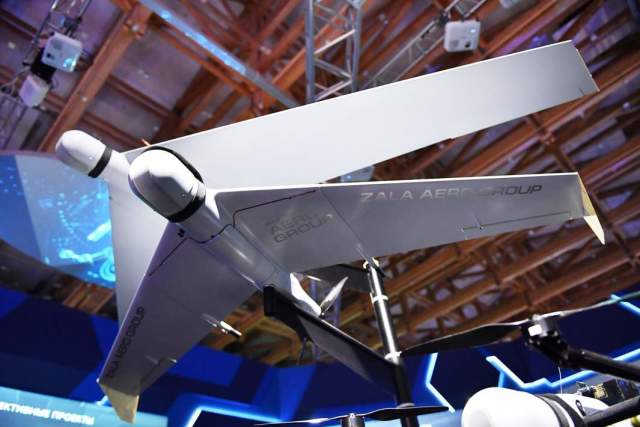
Unmanned aerial vehicles ZALA 421-16 at the exhibition "Russia looking to the future" in the Central Manege in Moscow
Image source:
It was also decided to install anti-aircraft weapons on the BDK as part of the new modernization program. But, as the interlocutors of the publication noted, the final decision on air defense has not yet been made. In particular, the installation of Tor anti-aircraft complexes on the BDK in a towed version is considered as an option.
It is planned to increase the self-defense systems of landing ships from marine drones. Currently, several options have already been developed for installing additional firing points with Kord machine guns on board the BDK, as well as electronic warfare stations.
Orlan-10 and ZALA drones
The multifunctional complex with the Orlan-10 UAV is used for aerial reconnaissance, radio technical reconnaissance of cellular subscriber terminals, blocking GSM cellular communications, distortion of the GPS navigation field, convoy support, target detection and fire correction. It performs flights at an altitude of up to 5 thousand meters at speeds up to 170 km / h, remaining in the air for 10 hours. The radius of application reaches 140 km.
The ZALA 421-04, 421-08 and 421-16 mini-planes have a range of up to 40 km, can take a load of 1.5 kg and stay in the air for up to two and a half hours. Slightly larger than the ZALA 421-20 — they operate within a radius of up to 120 km, flight time is 11 hours, load weight is up to 50 kg. They can combine on-board air navigation systems, automatic data decryption and laser targeting.
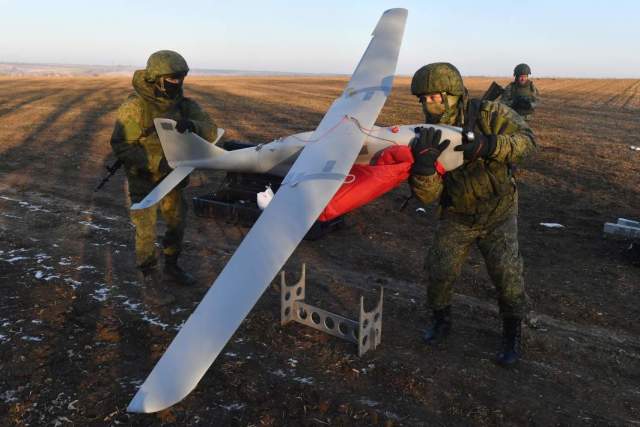
Servicemen of the Armed Forces of the Russian Federation disassemble the Orlan-10 unmanned aerial vehicle after completing a task in the southern sector of its
Image source: Photo: RIA Novosti
Russian servicemen, with the help of the BDK, conducted an amphibious operation in the Sea of Azov, transferred cargo, and patrolled our shores, military expert Dmitry Boltenkov told Izvestia.
— Landing ships are still cheaper than frigates. Also, according to the results of a special military operation, it became clear that they need to be strengthened, and artillery and machine-gun weapons should be additionally installed. Now they even began to use drones from the aircraft to conduct reconnaissance operations on enemy territory. These ships are now in great demand and necessary. Unfortunately, too many of them were disposed of in the 90s," he noted.
According to the expert, before the start of the special military operation, the Black Sea Fleet had the largest number of landing ships. At the same time, it was further strengthened by representatives of the Northern and Baltic Fleets.
Unmanned aircraft ZALA 421-20 at the exhibition of military equipment of Udmurtia factories in Izhevsk
Image source: Photo: RIA Novosti/Evgeny Biyatov
The former Chief of the General Staff of the Navy, Admiral Valentin Selivanov, explained that the firepower of the BDK is necessary for the successful conduct of amphibious operations.
— The enemy has a strong defense built near the shore, so before approaching, it must be suppressed, — he said. — That's why landing ships need firepower. Coastal fortifications will, of course, be beaten by our aircraft and detachments of fire support ships, but the landing ships themselves must, approaching the shore, hit all enemy defensive points where the troops land. So this is the right idea. Now the situation is changing, the enemy is strengthening the defense, therefore, the combat capabilities of landing ships should be greater.
Time-tested
The basis of the Russian amphibious fleet is now the BDK of project 775. They have long earned a reputation as the "workhorses" of the Navy. Since the middle of the last decade, they have participated in the so-called Syrian Express and provided the grouping of the Russian Aerospace Forces in the SAR. These raids began after inspections by European countries of bulk carriers delivering goods from Russia to Syria. Third countries cannot detain warships, therefore, the BDK of the Northern, Black Sea and Baltic Fleets were involved in cargo transportation.
On February 10, 2022, a detachment of large amphibious ships of the Russian Navy consisting of the Minsk, Korolev, Kaliningrad, Pyotr Morgunov, George the Victorious and Olenegorsky Miner entered Sevastopol, completing the transition around Europe. In the summer of the same year, it was reported that the largest grouping of 12 BDK of the Northern, Baltic and Black Sea Fleets operates in the Black Sea. These ships are engaged to transport cargo in the interests of Russian groups in the Donbas, as well as in the Kherson and Zaporizhia regions.

The large amphibious assault ship of the 775 Kaliningrad project during the call to the main base of the Black Sea Fleet — in the city of Sevastopol
Image source: Photo: TASS/Ministry of Defense of the Russian Federation
The BDK of Project 775 has been the target of attacks by Ukrainian militants more than once. So, on August 13, 2023, as a result of a Ukrainian rocket attack, the Minsk BDK was damaged. At that moment, he was under repair in the dry dock of the Sevastopol Marine Plant. At the same time, the Rostov-on-Don submarine project 636.3, which was standing in a nearby dock, was damaged. As a result of the impact, 24 people were injured.
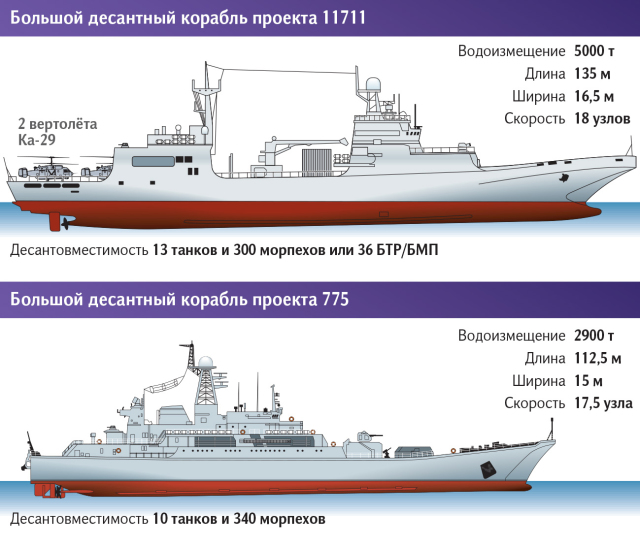
At that time, the Russian Defense Ministry assured that Minsk and the diesel submarine would be fully restored and would continue to serve in combat as part of the Navy. Izvestia reported that the BDK will be restored according to the updated project. It involves changing the upper superstructure, reviewing the composition of weapons and avionics.
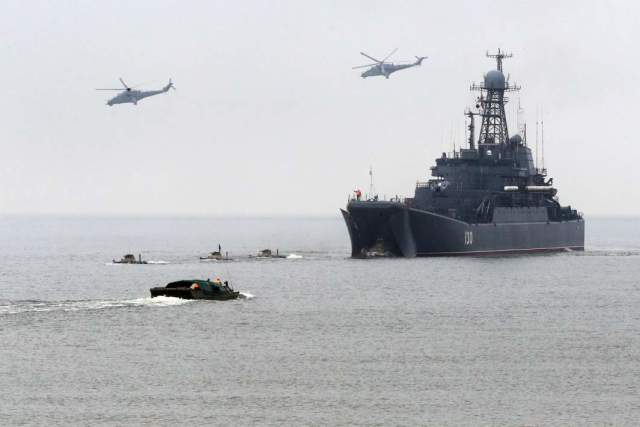
The large landing ship Korolev during tactical exercises of the units of the Marine brigade of the Baltic Fleet for the landing of amphibious troops at the Khmelevka training ground in the Kaliningrad region
Image source: Photo: RIA Novosti/Igor Zarembo
On December 26, 2023, the Russian Defense Ministry reported that the Novocherkassk BDK was damaged during the repulse of the VFU attack.
The BDK of Project 775 can carry up to 10 medium tanks and 340 people. They are designed for landing troops on an unprepared coast, as well as for transporting goods, including armored vehicles.
The ships are equipped with two 57mm AK-725 remote-guided artillery launchers, two Grad-M multiple launch rocket launchers, as well as four launchers of the Strela-2 portable anti-aircraft missile system.
The new generation
In recent years, the 775-series ships have been replaced by the BDK project 11711. The Ivan Gren, which joined the Navy in 2018, became the first amphibious assault ship created in the post-Soviet era. Today there are two representatives of the series in the ranks, the second was "Ivan Morgunov". Both serve in the Northern Fleet. The third and fourth ships, the Vladimir Andreev and Vasily Tushin, are under construction. They are created according to a modernized project.
Large amphibious assault ship of project 11711 "Ivan Gren" of the Northern Fleet of the Russian Federation at the berth of Severomorsk
Image source: Photo: RIA Novosti/Pavel Lvov
The ships of project 11711 were originally designed with the ability to operate in conditions of ice danger. They have a length of 120 m, a width of 16.5 m, a displacement of 5 thousand tons. The range reaches 6.5 thousand km, the speed is 18 knots, the duration of autonomous navigation is up to 30 days. They can take on board up to 300 troops, 13 tanks or 36 lighter armored vehicles. They can land them on an unequipped coast with four points of excitement at sea.
Alexey Mikhailov
Andrey Fedorov
Julia Leonova
